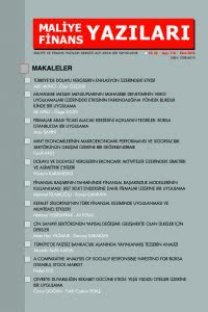Firmalar arası Ticari Alacak Kredisini Açıklayan Teoriler: Borsa İstanbul’da bir Uygulama
ticari kredi, kredili satış teorileri, ürün kalitesi teorisi, finansal aracılık teorisi, fiyat ayrımcılığı teorisi
Theories Explaining Interfirm Trade Credits: An Investigation in Borsa Istanbul
trade credit, credit sales theories, product quality theory, financial intermediation theory, price discrimination theory,
___
- Akin, O., Onat, O. K., Eser, E. D., & Dalgar, R. (2015). Kobilerin Alacak Yönetimi Politikalarının Belirlenmesine Yönelik Bir Araştırma: Burdur, Isparta ve Bucak Organize Sanayi Bölgelerinde Bir Uygulama. Süleyman Demirel University Journal of Faculty of Economics & Administrative Sciences, 20 (4), 285-304.
- Allen, F. (1984). Reputation and Product Quality. The RAND Journal of Economics, 15 (3), 311-327.
- Auboin, M., & Engemann, M. (2017). Testing the Trade Credit and Trade Link: Evidence From Data on Export Credit Insurance. Review of World Economics, 150 (4), 715-743.
- Bayrakdaroğlu, A., Sarı, B., & Heybeli, B. (2012). İşletmelerinin Finansal Risk Yönetiminde Türev Ürün Kullanımlarına İlişkin Bir Saha Araştırması: Denizli İli Örneği. Sosyal ve Beşeri Bilimler Dergisi, 4 (1), 11-21.
- Borde, S.F & McCarty, D.E. (1998). Determining The Cash Discount in The Firm’s Credit Policy: An Evaluation, Journal of Financial and Strategic Decisions, 11(2), 41-49.
- Brechling, F. P. R. & Lipsey, R. G. (1963). Trade Credit and Monetary Policy. The Economic Journal, 73 (292), 618-641. doi:10.2307/2228171
- Brennan, M. J., Maksimovic, V., & Zechner, J. (1988). Vendor Financing. Journal of Finance, 43 (5), 1127-1141.
- Brick Ivan E & Fung, William K. H (1984). The effect of taxes on the trade credit decision. Financial Management, (2), 24.
- Coşkun, E., & Kök, D. (2011). Çalışma Sermayesi Politikalarının Karlılık Üzerine Etkisi: Dinamik Panel Uygulaması. Ege Academic Review, 11, 75-85.
- Cömert, Ç.E. (2011). Alacak Yönetiminin Önem ve Rolünün Uluslararası Finansal Raporlama Standartları (UFRS) Çerçevesinde Değerlendirilmesi. Muhasebe ve Denetime Bakış, (34), 89-105.
- Dun and Bradstreet Inc. (1959). How to Control Accounts Receivable for Greater Profits, New York, 1959.
- Emery, G. W. (1984). A Pure Financial Explanation For Trade Credit. Journal of Financial & Quantitative Analysis, 19 (3), 271-285.
- Emery, G. W. (1987). An Optimal Financial Response to Variable Demand. Journal of Financial & Quantitative Analysis, 22 (2), 209-225.
- Ferris, S. J. (1981). A Transactions Theory of Trade Credit Use. The Quarterly Journal of Economics, (2), 243.
- Gill A, Biger N., & Mathur N,. (2010). The Relationship Between Working Capital Management and Profitability: Evidence From The United States. Business and Economics Journal, 2, 1-9.
- Gitman L.J. & Zutter C. J. (2014). Principles of Managerial Finance, England: Pearson (14 th global edition). ISBN: 10: 1-292-01820-8
- Kalman J. Cohen & Frederick S. Hammer (1966). Analytical Methods in Banking, Richard D. Irwin, Inc., Homewood, 111. 131-4.
- Kong, J., Zhou, Y., Lai, H., Zhang, F., & Zhou, Z. (2016). Analysis of Credit Sale Risk of Emerging Market Product. Procedia Computer Science, 91, 362-371. doi:10.1016/j.procs.2016.07.097
- Kök, D., & Aksu, G. (2013). Müşteri Kredi Değerliliğinin Belirlenmesinde Analitik Ağ Süreci Kullanımı: Bir Model Önerisi. Journal of Accounting & Finance, (59), 167-185.
- Laffer, A. B. (1970). Trade Credit And The Money Market. Journal of Political Economy, (2), 239.
- Long, M.S., Malitz, I.B. & Ravid, S.A. (1993). Trade credit, Quality Guarantees, and Product Marketability. Financial Management, (4), 117-127.
- Mao,J. & Sarndal, C. (1974). Controlling Risk in Accounts Receivable Management. Journal of Business Finance & Accounting, 1 (3), 395-403. doi:10.1111/j.1468-5957.1974.tb00871.x
- Meltzer, A.H. (1960). Mercantile Credit, Monetary Policy, and Size of Firms. The Review of Economics And Statistics, (4), 429. doi:10.2307/1925692
- Mian, S. L., & Smith, C. J. (1992). Accounts receivable management policy: Theory and Evidence. Journal of Finance, (1), 169.
- Ng, C.K., Smith, J.K & Smith, R.L. (1999). Evidence on The Determinants of Credit Terms Used in Interfirm Trade, The Journal of Finance, 54 (3), 1109-112.
- Petersen, M. A., & Rajan, R.G. (1997). Trade Credit: Theories and Evidence. The Review of Financial Studies, (3), 661-691.
- Sabuncu, B. & Çakır, H. M., (2015). Riskten Korunma Aracı Olarak Türev Araç Kullanımı: BİST 100 Örneği. Akademik Sosyal Araştırmalar Dergisi, 3 (19), 268-288.
- Schwartz, Robert A. (1974). An Economic Model of Trade Credit. The Journal of Financial And Quantitative Analysis, (4), 643. doi:10.2307/2329765
- Smith, J.K. (1987). Trade Credit And Informational Asymmetry. The Journal of Finance, 42 (4), 863-872.
- Şamiloğlu, F., & Akgün, A. İ. (2016). The Relationship Between Working Capital Management and Profitability: Evidence from Turkey. Business & Economics Research Journal, 7 (2), 1-14. doi:10.20409/berj.2016217492
- Yücel, T., Mandacı, P.E. & Kurt, G.(2007). İşletmelerin Finansal Risk Yönetimi ve Türev Ürün Kullanımı: İMKB 100 Endeksinde Yer Alan İşletmelerde Bir Uygulama. Muhasebe ve Finansman Dergisi, 36, 106.
- Yılmaz, E. & Arslan, T. (2016). Finansal Risklerin Yönetilmesinde Türev Ürünlerin Kullanımı: Borsa İstanbul (BİST) 100 Endeksi’ndeki Şirketler Üzerine Bir Araştırma. İşletme Araştırmaları Dergisi, 8(1). 663-678
- Zainudin, N., & Regupathi, A. (2010). Manufacturing SMES' Credit Collection Period and Its Determinants: Some Evidence From Malaysia. Folia Oeconomica Stetinensia, 83-104. doi:10.2478/v10031-010-0011-9
- ISSN: 1308-6014
- Yayın Aralığı: Yılda 2 Sayı
- Başlangıç: 2008
- Yayıncı: Maliye ve Finans Yazıları Yayıncılık Ltd. Şti.
Çevreye Duyarlılığın Rekabet Gücüne Etkisi: Yeşil Yıldızlı Oteller Üzerine Bir Uygulama
Öznur DOĞAN, Fatih Coşkun ERTAŞ
Çin Sanayi Sektörünün Yapısal Değişimi: Gelişmekte Olan Ülkeler için Dersler
Mete Han YAĞMUR, Gencay KARAKAYA
Kefalet Sigortası'nın Türk Finansal Kesiminde Uygulanması ve Muhtemel Etkileri
Türkiye’de Dolaylı Vergilerin Enflasyon Üzerindeki Etkisi
Firmalar arası Ticari Alacak Kredisini Açıklayan Teoriler: Borsa İstanbul’da bir Uygulama
A Comparative Analysis Of Socially Responsible Investing For Borsa Istanbul Stock Market
Mehmet İSLAMOĞLU, Samet ÇANKAYA
Dolaylı ve Dolaysız Vergilerin Ekonomik Aktiviteler Üzerindeki Simetrik ve Asimetrik Etkileri
